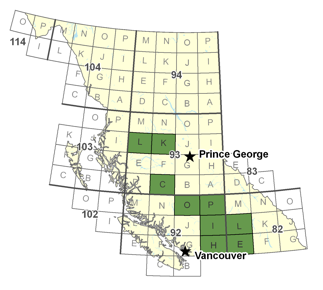Summary
 This project will provide detailed geochemical (major and trace element) and isotopic (Sr, Nd, Pb, and Hf) compositional information for latest Triassic to late Jurassic porphyry intrusions in south-central British Columbia (Quesnellia and Stikinia terranes, NTS mapsheets 92I, 92O, 92P, 93C). The late Triassic intrusions in this area tend towards alkalic compositions (monzonitic), and many host significant porphyry deposits (Cu-Mo-Au-Ag; e.g. Copper Mountain, Afton/Ajax, Highland Valley). The younger phases under study are calc-alkaline (e.g. early Jurassic hornblende-biotite granodiorites, middle Jurassic granites, latest Jurassic tonalites).
This project will provide detailed geochemical (major and trace element) and isotopic (Sr, Nd, Pb, and Hf) compositional information for latest Triassic to late Jurassic porphyry intrusions in south-central British Columbia (Quesnellia and Stikinia terranes, NTS mapsheets 92I, 92O, 92P, 93C). The late Triassic intrusions in this area tend towards alkalic compositions (monzonitic), and many host significant porphyry deposits (Cu-Mo-Au-Ag; e.g. Copper Mountain, Afton/Ajax, Highland Valley). The younger phases under study are calc-alkaline (e.g. early Jurassic hornblende-biotite granodiorites, middle Jurassic granites, latest Jurassic tonalites).These phases are not recognized as significant hosts to mineralization in southern British Columbia, although contemporaneous mineralizing events are recognized in central to northern British Columbia (e.g. Eskay Creek). Publication of the results of the proposed geochemical and isotopic study will achieve three goals:
- Provide comprehensive compositional information for the targeted intrusions
- Provide a petrologic and tectono-magmatic framework to explain the apparent change from alkalic (mineralized) to calc-alkalic (non-mineralized) compositions in earliest Jurassic time.
- Test whether attenuated Precambrian crust (ancestral North America) lies beneath Quesnellia by using radiogenic isotopic systematics of granitic rocks as crustal probes.
The work to be undertaken in this project forms part of a larger PhD study, which reexamines the tectonic affinity and history of the upper crustal Quesnel and Stikine terranes of the Intermontane belt relative to mid-crustal plutons of the Coast Plutonic Complex situated to the west.